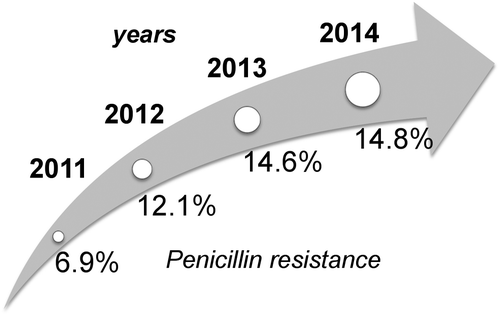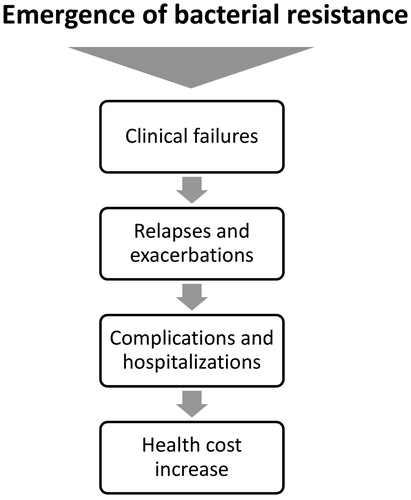Figures & data
Table 1 Percentage incidence of bacterial species within the spectrum of lower respiratory tract infection (LRTI)-associated pathogens
Table 2 Statements defined by the scientific steering committee into four main topics and submitted to the expert panel of the Delphi-based consensus. The percentage of consensus reached for each statement is reported
Figure 1 Constant increase of bacterial non-susceptibility to penicillin in S. pneumoniae, expressed as percentage of intermediate and resistant strains (% I+R) observed in Italy from 2011 to 2014 and further raising trend in the following years.

Table 3 Consensus on the management of acute LRTIs. Percentage of agreement to the statements of topic 1: Issues in aetiology and antibiotic resistance involved in the process of prescribing antibiotics
Table 4 Different spectrum of activity among oral cephalosporins on S. pneumoniae
Figure 2 Structural formulas of three representative cephem molecules and functional groups determining spectrum activity. Ceftaroline (Fifth generation) (a) is characterized by the presence of the thiazole-pyridine rings in C3 position conferring broad-spectrum activity against Gram-positive species. Ceftriaxone (Third generation) (b) carries the methoxyimino group and the aminothiazole substitution in the C7 side chain, granting a good β-lactamase stability and a higher activity on Gram-negative bacteria. Cefditoren (Third generation) (c) possess all these functional groups and possess full spectrum of activity both on Gram-positive and Gram-negative bacteria. Black circle, methoxyimino group (beta-lactamase stability); grey circle, aminothiazole group (activity against Gram-); dashed circle, methylthiazole group (activity against Gram+).

Table 5 Consensus on the management of acute LRTIs. Percentage of agreement to the statements of topic 2: Pharmacological issues involved in the practice of prescribing antibiotics
Table 6 Consensus on the management of acute LRTIs. Percentage of agreement to the statements of topic 3: Clinical considerations on the management of patients with CAP, AECB and COPD
Figure 3 Schematic representation portraying the consequences of the emergence of bacterial resistance to antibiotics. The risk of therapeutic failure favours relapses and exacerbation of LRTI symptoms, leading to increased incidence of hospitalization with consequent increase of health costs. This scenario abates the cost effectiveness of antibacterial therapy.

